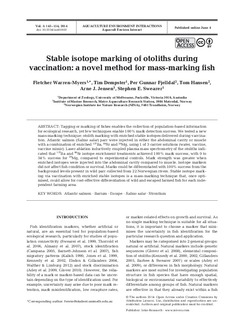| dc.contributor.author | Warren-Myers, Fletcher | |
| dc.contributor.author | Dempster, Tim | |
| dc.contributor.author | Fjelldal, Per Gunnar | |
| dc.contributor.author | Hansen, Tom | |
| dc.contributor.author | Jensen, Arne Johan | |
| dc.contributor.author | Swearer, Stephen E. | |
| dc.date.accessioned | 2014-06-11T07:48:28Z | |
| dc.date.accessioned | 2017-08-02T11:40:22Z | |
| dc.date.available | 2014-06-11T07:48:28Z | |
| dc.date.available | 2017-08-02T11:40:22Z | |
| dc.date.issued | 2014 | |
| dc.identifier.citation | Aquaculture Environment Interactions 2014, 5:143-154 | nb_NO |
| dc.identifier.issn | 1869-215X | |
| dc.identifier.uri | http://hdl.handle.net/11250/2449734 | |
| dc.description.abstract | Tagging or marking of fishes enables the collection of population-based information
for ecological research, yet few techniques enable 100% mark detection success. We tested a new
mass-marking technique: otolith marking with enriched stable isotopes delivered during vaccination.
Atlantic salmon (Salmo salar) parr were injected in either the abdominal cavity or muscle
with a combination of enriched 137Ba, 86Sr and 26Mg, using 1 of 3 carrier solutions (water, vaccine,
vaccine mimic). Laser ablation inductively coupled plasma mass spectrometry of the otoliths indicated
that 137Ba and 86Sr isotope enrichment treatments achieved 100% mark success, with 0 to
34% success for 26Mg, compared to experimental controls. Mark strength was greater when
enriched isotopes were injected into the abdominal cavity compared to muscle. Isotope markers
did not affect fish condition or survival. Marks could be differentiated with 100% success from the
background levels present in wild parr collected from 22 Norwegian rivers. Stable isotope marking
via vaccination with enriched stable isotopes is a mass-marking technique that, once optimised,
could allow for cost-effective differentiation of wild and escaped farmed fish for each independent
farming area. | nb_NO |
| dc.language.iso | eng | nb_NO |
| dc.rights | Navngivelse 4.0 Internasjonal | * |
| dc.rights.uri | http://creativecommons.org/licenses/by/4.0/deed.no | * |
| dc.subject | Atlantic salmon | nb_NO |
| dc.subject | Barium | nb_NO |
| dc.subject | Escape | nb_NO |
| dc.subject | Salmo salar | nb_NO |
| dc.subject | Strontium | nb_NO |
| dc.title | Stable isotope marking of otoliths duringvaccination: a novel method for mass-marking fish | nb_NO |
| dc.type | Peer reviewed | nb_NO |
| dc.type | Journal article | |
| dc.date.updated | 2014-06-11T07:48:29Z | |
| dc.source.pagenumber | 143-154 | nb_NO |
| dc.source.volume | 5 | nb_NO |
| dc.source.journal | Aquaculture Environment Interactions | nb_NO |
| dc.identifier.doi | 10.3354/aei00103 | |
| dc.identifier.cristin | 1137403 | |
| dc.relation.project | Fiskeri- og havbruksnæringens forskningsfond: 900710 | nb_NO |
| dc.relation.project | Norwegian Fisheries and Aquaculture Research Fund: 900710 | nb_NO |

